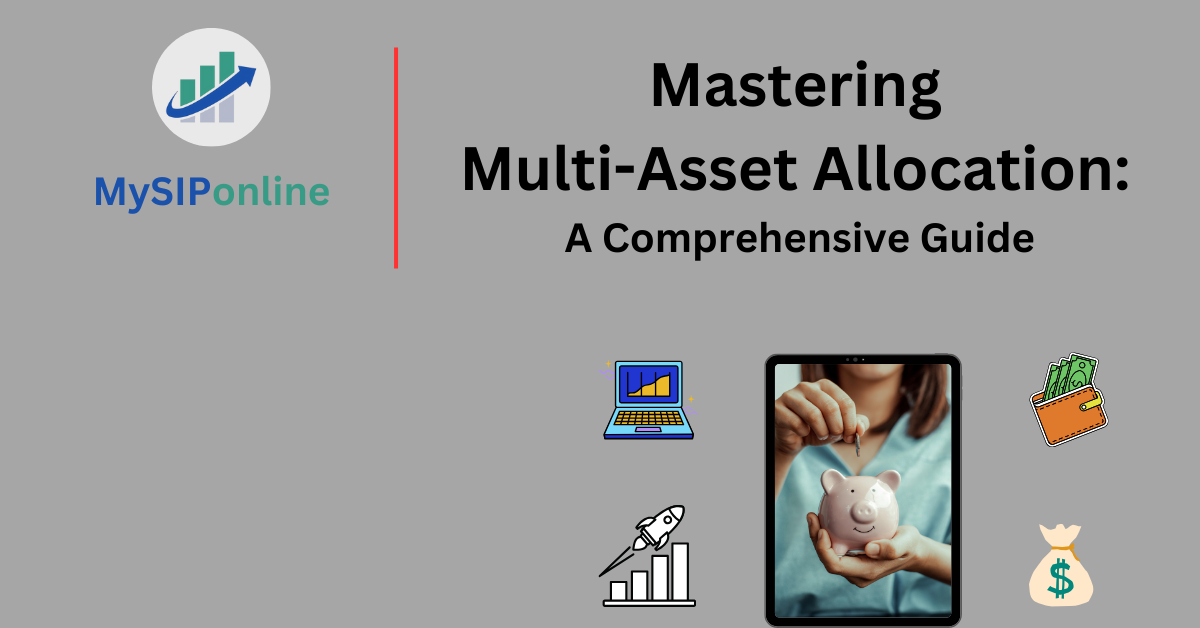The Multi-Asset Allocation Funds is a strategy that involves spreading your investments among many asset classes such as Equities, Debt, and Cash rather than putting all of your money into one. It is like having a diverse set of tools in your financial toolkit to assist you control risk as well as boost returns over time.
This category offers the freedom and flexibility to explore different assets and asset classes. These asset classes typically present lower risk and more stable market conditions, making them easier to manage while potentially yielding better profits.
In this article, we’ll explore how asset allocation has led to a remarkable performance in mutual funds, along with discussing its advantages and purpose. Additionally, we’ll highlight the best funds available for investment in this category.
Benefits of Multi Asset Allocation?
Count some benefits of the multi-asset category-
Risk Diversification
Spreading assets across various asset classes reduces the impact of poor performance in any one asset class.
Enhanced Portfolio Stability
Combining assets with low correlation might result in smoother portfolio returns over time, lowering total volatility.
Potential for Greater Returns
By distributing assets across asset classes, investors may take advantage of the growth potential of various markets and industries, potentially leading to greater overall returns.
Adaptable to Market Circumstances
Multi-asset offers the flexibility of shifting portfolio allocations in response to changing market conditions, therefore maximizing returns while reducing risk.
Adjusted to what investors want
Investors can adapt their asset allocation strategy to how much risk they are comfortable with, what they hope to achieve with their investments, and how long they intend to invest, ensuring that it with their financial goals.
Reduced dependency on the market timing
Rather than attempting to time the market, multi-asset allocation focuses on long-term strategic allocation, eliminating the need to forecast short-term market fluctuations.
Improved Risk-Adjusted Returns
Asset allocation seeks to produce higher risk-adjusted returns than individual asset-class investments by optimizing the risk-reward balance across several asset classes.
What are the Objectives of the Multi-Asset Category?
The fundamental goal of multi-asset allocation funds is to optimize and diversify investment portfolios by distributing assets across different asset classes. Instead of investing only in one form of asset, such as equity and debt, these fund spread their money across many asset classes, including stocks, bonds, real estate, and cash. This technique seeks to decrease total portfolio risk by avoiding depending entirely on the performance of a single asset type.
For example, if one asset class has a downturn, the performance of the other asset classes may serve to mitigate the impact on the total portfolio. Diversifying across asset classes allows investors to attain a more stable and perhaps greater long-term return.
Tax implications
Investors should also examine the tax consequences of investing in asset allocation funds. If an investor keeps these funds for less than three years, any profits realized from selling them will be subject to short-term capital gains tax. The tax rate will be determined by the investor’s appropriate income tax slab.
On the other hand, if investors keep their investments for longer than three years, they would face long-term capital gains tax. This tax is now charged at 20%, with indexation advantages. Indexation enables investors to adjust the purchase price of their investments for inflation, thus lowering the taxable amount and hence the tax payment.
Top 5 Funds of Multi-Asset Allocation
- ICICI Prudential Multi-Asset Fund
- HDFC Multi-Asset Fund
- Quant Multi Asset Fund
- Motilal Oswal Balanced Advantage Fund
- Baroda BNP Paribas Balanced Advantage Fund
Who Should Invest in?
Conservative Investors
Individuals who value capital preservation and are risk-averse may be interested in asset allocation funds. These funds often combine low-risk assets such as debt or cash with equity giving a balance of stability and possible gain.
Moderate Investors
Investors with a moderate risk tolerance who want to take a balanced strategy may profit from multi-allocation funds. These funds provide diversification across asset classes, with the goal of balancing growth potential with risk control
Aggressive Investors
Those willing to take on more risk in exchange for possibly larger returns can choose a multi-asset fund. These funds frequently have a higher exposure to stocks or alternative assets, giving more growth potential while maintaining some amount of diversification.
Long-term Investors
Individuals with a long investing horizon, such as those saving for retirement or other long-term goals, may find multi-asset funds appealing. These funds are intended to perform well in the long run by diversifying across asset classes, allowing investors to ride out market swings.
Investors with Limited Time
Individuals who want a hands-off approach to investing or do not have the time or skills to manage a diverse portfolio may choose multi- allocation funds. These funds are professionally managed, allowing investors to entrust investing choices to highly experienced fund managers.
Investors Seeking Diversification
Asset allocation funds may be of interest to those who want to spread their assets across several asset classes in order to lessen the risk associated with any one investment. By diversifying among asset classes, investors can lower their exposure to market volatility while increasing the risk-adjusted returns on their portfolio.
Factors Consider Before Investing?
Before investing, you should examine the following factors
Risk Tolerance
Determine your comfort level with risk. Understand how much volatility you can accept in your investments and select assets or funds that are appropriate for your risk level.
Investment Goals
Clearly state your investment objectives, whether they are short-term, such as purchasing a home, or long-term, such as retirement planning. Your investment plan should reflect these objectives to guarantee that you are investing in assets that will help you attain them.
Time Horizon
Determine your investing time horizon, or how long you intend to hold your investments. Your time horizon will affect your asset allocation and risk tolerance. Longer time horizons typically allow for more aggressive investing strategies, whilst shorter time horizons may need a more cautious approach to wealth preservation.
Conclusion
In summary, asset allocation funds offer investors a way to diversify their portfolios and manage risk effectively. By spreading investments across various asset classes, these funds cater to different risk appetites and investment goals. Before investing, consider your risk tolerance, investment objectives, and time horizon. Additionally, implementing a Systematic Investment Plan (SIP) can help you invest regularly and strategically. Overall, multi-allocation funds provide a flexible and efficient way to build a well-balanced investment portfolio.



